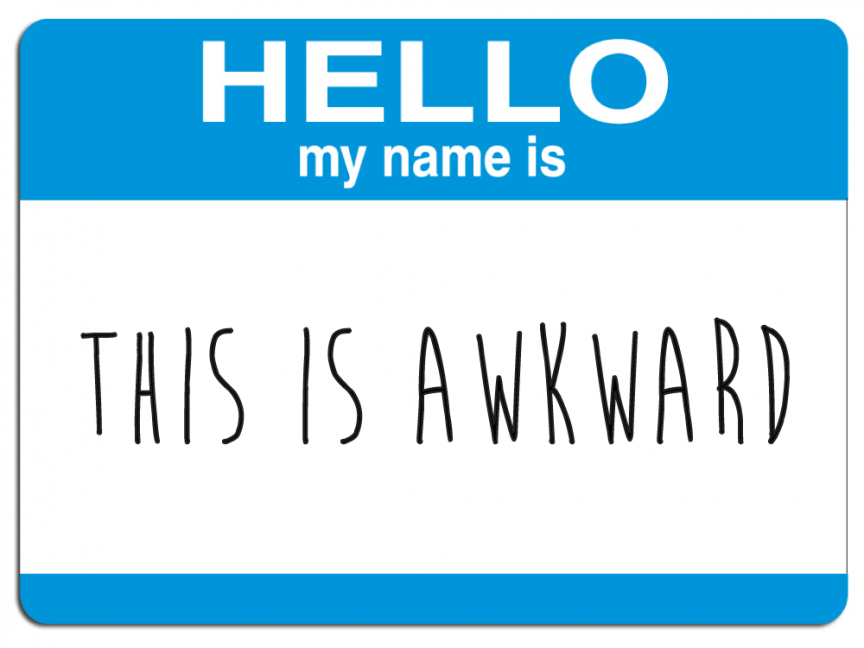This seemingly small and insignificant aspect of your event might appear trivial in comparison to your venue or speaker choice. However, contemplating the use of name tags does not mean you’re making a mountains out of a molehills. It really means that you are merely considering the tone you want to set at your event, and the way you want your attendees to interact with one another.
Placing a name tag or badge on an attendee can lead to awkward and stale conversations because each individual is looking for a name instead of really listening to what that other person has to say. Needless to say, if your event is based around “networking”, or connecting one human to another, you might want to reconsider the use of name tags. Here’s why:
No Introductions
When there’s a little piece of paper with a name scribbled on it, you don’t feel the need to reach out and say, “Hello, my name is Emily. What’s yours?” Events give everyone a chance to meet new people and broaden their friendship or business circle. However, if you don’t ever introduce yourself or have the opportunity to meet someone on at least a surface level (what brings you to this event, have you been before, what interests you in such and such etc.), it’s pretty unlikely that you’ll ever get to know that person on a deeper level.
Eric Mottard, Eventoplus Director General, commented on the principle of discarding name tags by saying, “The idea is that people really connect rather than awkwardly try to read a name when the other party is not looking. It is true, you really do listen to the other party rather than try to spot a name.”
Connection Barriers
Instead of greeting a person, introducing yourself, and learning what makes that person tick, you might find yourself awkwardly approaching a stranger while squinting to read his or her name on a little piece of laminated paper. Or, maybe you can’t pronounce his or her name, so you decide to save yourself the embarrassment of butchering it by leaving their name out of the conversation altogether. While this situation isn’t doesn’t mean the world is coming to an end, it’s certainly not ideal. Dale Carnegie, the author of How To Win Friends And Influence People, states, “Names are the sweetest and most important sound in any language.” Our name is a core part of our identity. Saying someone’s name actually validates his or her existence, which makes us much more inclined to feel positively about the person that validates us.
If you’re married to your event’s name tags and feel naked without them, here are some tips that might help you remedy some awkward conversations and break down conversation barriers.
Size
Make sure that the font and name tag itself is readable from ten feet away. A baseline font size is 24 point, but it’s always okay to make it bigger! According to a nametag survey done by David Alder of Biz Bash, 50% of a group of meeting planners claimed “illegible font size of nametags was a major problem.” Bypass legibility issues by avoiding script, cursive, and other intricate typefaces.
Color
Although it’s fun to get creative with your name tags, simpler (in most cases) is more effective. A white background behind a dark color font will allow for maximum visibility for your name, position, and logo. Dark background colors have a tendency to distract viewers from the key components of your name tag.
Quality
There are a couple factors to consider as far as name tag quality goes. The first: low quality name tags tend to loose their grip and “curl” within the first hour of use. The second: higher quality name tags will stick for hours, but have the potential of leaving a sticky residue on one’s clothing. Knowing this, consider your audience and which quality type will best suit their needs.
Custom Made
If you’re going to a tradeshow or event that requires you to wear a name tag, make and bring your own! Customize them to fit the requirements listed above and give you a unique and memorable edge.
The Bottom Line
Getting your attendees to interact on a deeper level might not be at the top of your list of event goals. However, encouraging guests to connect with one another (even just on a surface level) should be. This is how buzz gets generated and people mark off dates on their calendars to plan for your next event. No one likes feeling awkward and no one enjoys feeling left out. So, creating an environment where your attendees can feel comfortable and confident to present themselves to one another is essential. If you’re not into the idea of ditching name tags, make an effort to provide quality tags or encourage people to make and bring their own. If you feel a sense of freedom and empowerment by throwing out your old name tags, then listen to the wise words of Dale Carnegie, “You can make more friends in two months by becoming interested in other people than you can in two years by trying to get other people interested in you.”

